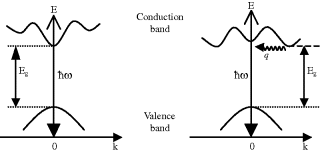4.10 Recombination and Luminescence
The process opposite to absorption is emission. Since in semiconductors the excess electrons and holes recombine, the excess energy is given up in the form of photons. The general name luminescence is given to the phenomenon of light emission. In this section, the recombination and luminescence processes will be discussed.
4.10.1 Luminescence Lifetime
Band-to-band absorption leads to the creation of an excess electron–hole pair. These excess carriers have relatively short lifetimes and tend to recombine with the emission of a photon. The recombination processes for direct- and indirect-gap semiconductors are shown in Figure 4.8. Just like absorption, a radiative transition can be direct or indirect depending on the type of semiconductor.
Figure 4.8 Recombination processes in a direct-gap (left) and an indirect-gap (right) semiconductor.

The electrons and holes generated by absorption may lie in a state higher than the band edge in the respective band. Before recombination, the energetic particles thermalize, that is, they come to the lowest lying states in the bands. In direct band gap semiconductors, conduction band and valence band extrema occur at the zone center. The electron can readily make a transition to the valence band. Note that the same momentum conservation condition as in Eq. (4.36) should be satisfied. Since the photon has negligible ...
Get Silicon Photonics: Fundamentals and Devices now with the O’Reilly learning platform.
O’Reilly members experience books, live events, courses curated by job role, and more from O’Reilly and nearly 200 top publishers.

